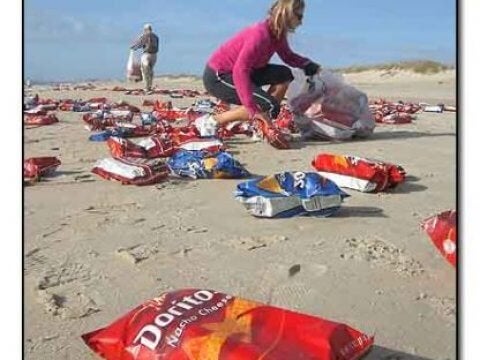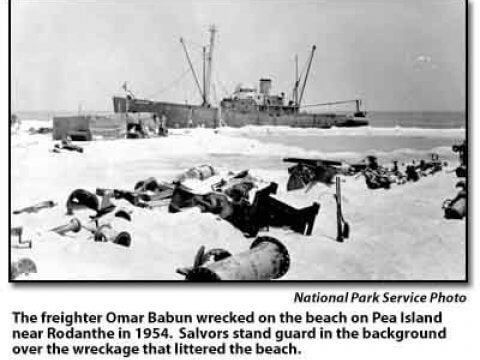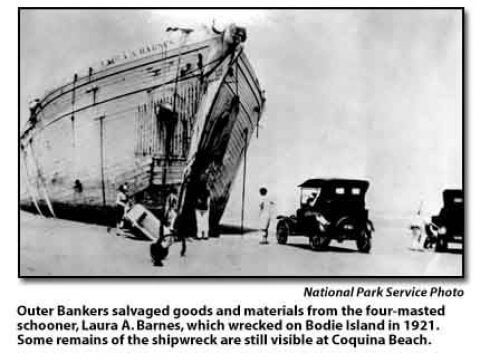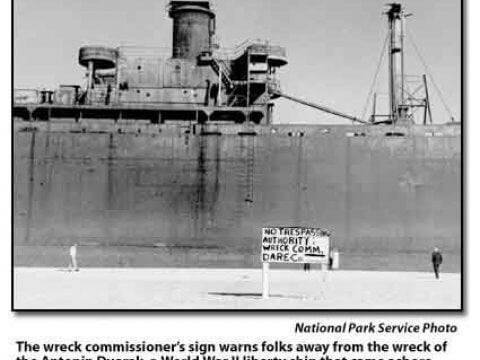Limited time only! Book now for 25%* down and pay the second installment of 25% 30 days later.
Limited time only! Book now for 25%* down and pay the second installment of 25% 30 days later.

Want to hear a story about the history of OBX shipwrecks? The Outer Banks has a rich history of shipwrecks along its Atlantic shipping lane, a route that sees hundreds of ships riding the Gulf Stream daily, and with the Labrador Current passing within sight of the beach. OBX Shipwrecks are often the result of treacherous storms and shifting sands that made navigation through the Atlantic a daunting task. Despite their tragic end, these wrecks offer a fascinating look into the past, each with its own unique story to tell.
Today’s blog is written by Daniel, a seasoned writer, and historian who has been chronicling the rich history of Hatteras and Ocracoke islands since his high school days. As a contributor to The Island Free Press, he has shared his passion for the islands’ past with readers for years.
Thursday, Nov. 30, 2006, dawned bright and warm on Hatteras, and the regulars at the Frisco Rod & Gun loitered around the coffee, talking about fishing, gas prices, and the latest “he said-she said.” Uneventful as the day began, that changed big time when a wild-eyed, out-of-breath local stuck his head in the front door and yelled, “Containers washed up at the bathhouse! There’s jillions of bags of Doritos all over the beach!” ater that day, as the novelty of the story worked its way into the national media, an employee of the Rod & Gun remarked to one of the papers that, “In the blink of an eye it was just the employees left standing there, stunned, looking at each other. The place emptied in, like, 12 seconds.”
Down through history, that kind of mad scramble has been nothing unusual for the islanders. It is a scenario that has played out hundreds of times before.
We were just doing what comes naturally.
Shipwreck salvaging, or wreck busting, is a time-honored tradition. It was altogether lucrative during the 1700s, 1800s, and early 1900s, and the largest cash industry on the coast. With large sums of money at stake, it was also intensely competitive. It was not uncommon on Hatteras and Ocracoke for islanders to pull down as much as $800 a pop or for a group of men to split several thousand dollars.
Many years ago, David Stick underscored the intensity of wreck busting in an interview he conducted with an insurance agent at Ocracoke for his book, “Graveyard of the Atlantic.”
“The Ocracokers,” the man said, “would drop a body while carrying it to the grave, and leave it on the road, or leave Sunday services, if someone yelled, ‘Ship ashore!'”
Actually, there appears to be some basis for that assessment. Brother L. O. Wyche, beloved preacher at Ocracoke, was conducting a revival at the Methodist Church in the mid-1890s when word spread through the congregation that a lumber-laden vessel had struck near The Swash.
Preaching came to a halt as the men executed an orderly dash out the doors. The next night, one of the ladies of the church scolded Brother Wyche, saying the episode was unchristian-like, and our Lord could not possibly condone such intoxicating behavior.
The eloquent Wyche, hat in hand, politely responded, “Don’t dwell on it, good sister. He’d have done the same thing for us .”
Long before there was an Interstate 95, with thousands of tractor-trailers hauling commerce up and down the East Coast from Miami to Boston, there was an I-95 of sorts right off Hatteras and Ocracoke. It was the great Atlantic shipping lane, with hundreds of ships every day riding the Gulf Stream and the Labrador Current and passing within sight of the beach, from the earliest ships of the Age of Discovery right up through World War II. As the Doritos saga aptly showed, those shipping lanes are still used by maritime traffic today.
As with accidents in bad weather on I-95, on our beaches there were shipwrecks, and in the case of major storms, several at one time. When they came, islanders summoned their inner busters and dropped meager subsistence livings, such as fishing, oystering, or boat building, to concentrate their full focus on wrecking.
When a ship wrecked along the beach, the international maritime salvage laws came into play. It is still recognized law today, with some exceptions. Simply stated, the first on board took possession, providing they “raced” to reach the notary public to have their claim registered.
The following is a typical account taken from the wreck commissioner’s logbook of Caleb B. Stowe, one of two archived at the Graveyard of the Atlantic Museum in Hatteras.
“State of North Carolina, Hyde County, April 27th, 1858. Messrs. Zorababel Gaskins, Robert Rollinson and Caleb Stowe personally came and appeared before me Joshua H. Dailey, Notary Public, and have this day petitioned me in my official capacity and says that the aforesaid gentlemen are in command of a certain Schooner called Charles Roberts of Rockland in the state of Maine of the Burthen of One hundred and Seventy tons or thereabouts under Master Daniel E. Post of Bucksport in the state of Maine laden with a cargo of corn, shingles, tar, pitch and turpentine and that while engaged on a voyage from the Port of Charleston SC Capt. Post has on the Twenty Sixth Inst. been unfortunately shipwrecked on Outer Diamond off Cape Hatteras and crew except Capt. Post and First Mate Benjamin Davis of Bristol in the state of Maine cast ashore on the seabeach south of said sand reef. Vessel unmanageable as foremast and mainmast broken away and mainsail and mizzen-sails torn to flinders and fast on Diamond and aforesaid gentlemen advised Capt. Post after deliberation with him on his misfortune and succeeded by aid of lighters in unloading and getting said Schooner afloat whereupon she struck Middle Diamond taking on water through her hatches and listed to starboard. Therefore the aforesaid gentlemen in attendance with Capt. Post petitions me to approve a survey of goods and competent men to go on board the Charles Roberts and a true examination made of all materials and things relative to the condition of said Schooner and the cargo of her and in agreements and aid of Capt. Post with their advice in regard to what course deemed most proper for him to pursue to promote the rights, privileges and interest of all parties concerned in said vessel and her cargo. Having therefore full faith and confidence in your integrity, skill and judgment in such matters I do hereby nominate and appoint you for that purpose and request that you will immediately repair to and board the said Schooner and her cargo in concurrence respect, faith, and fairness with Capt. Post and report the same to me on oath of the Holy Evangelist of Almighty God and under your signatures. Given under my hand and seal at Cape Hatteras NC this 27th April 1858. Joshua H. Dailey, Notary Public, Zorababel Gaskins, Robert Rollinson, Caleb Stowe, Capt. Daniel Post, Benj. Davis (signatures).
North Carolina is still a “race” state today — first to record gets first position. Wreck busters were not pirates. They simply acted within the law. The original ship owners, with the captain as their representative, still possessed priority rights. The common sense thinking of common law countries pursued a view that saving the cargo of a wrecked ship meant compromises.
A respected community leader, wrote Charles Williams II in “The Kinnakeeter,” was appointed wreck commissioner by the governor, who acted on the recommendation of the township’s representative to state government. Hatteras and Ocracoke, prior to the arrival of the U.S. Postal Service in 1870, were delineated into four townships — Chicamacomico Banks, Kinnakeet Banks, Hatteras Banks, and Ocracoke.
At the first news of a wreck, the commissioner went to the scene. He was similar to a U.S. marshal in that he was the authority figure to keep order — to prevent the ship from being plundered. As such, he was there first and foremost to protect the rights of the ship’s owners and their insurers and, secondly, to allow the salvagers to perform their services of unloading the ship.
In addition to representing the government and keeping control of salvage operations, the commissioner was also responsible for the vendue, loosely the English translation and pronunciation of the French verb, “vendre,” which means “to sell.” At the vendue, the commissioner presided over an auction sale of the ship and its contents on the beach at the scene of the wreck. His fee was set by law at five percent. Needless to say, the wreck commissioner enjoyed a measure of prosperity in his life.
In most cases, the ship’s owners and wreck busters split the remaining balance 50-50. Many factors, however, came into play that often caused disagreements. If the captain or owners could not prove total ownership, whether by loss of papers or questionable dealings, the wreck commissioner would call in an arbitrator. If there was a cloud on the vessel’s ownership or bad faith dealings on part of the owners, it was not unusual for the arbitrator to award wreck busters as much as 75 percent.
Similarly, if the salvors had acted unlawfully or not dealt in good faith, the owners were awarded a higher percentage. The character and integrity of wreckers were held to a high standard. In some cases, if the wreckers had indeed acted unlawfully or if the cargo was of considerable value, buyers from northeastern North Carolina or Hampton Roads in Virginia often bid on the merchandise as a whole.
Wreckers were then employed to handle the cargo. A recent example of this was the 1976 beaching between Kinnakeet and Chicamacomico of the World War II liberty ship Betelgeuse, bound from Philadelphia to a Galveston scrap yard, when it was cut loose by the sea tug towing her as bad weather threatened to wreck both vessels. Two Rodanthe men, Mac Midgett and Steve Midgett, the first to board her under maritime salvage laws and after the prerequisite trip to a notary, were awarded an undisclosed amount of money to “guard” the vessel by the insurance company.
The earliest known recorded shipwreck salvaging effort on our shores occurred in late January of 1698, when the Swift Advice, bound for England from Williamsburg, was scuttled in an ice storm exiting the Chesapeake Bay, subsequently beaching at Chicamacomico.
The Swift Advice was no ordinary ship — not by a long shot. It was owned by none other than King William, and was outfitted with the best guns, furniture, sails, and provisions of the day. In a bit of intrigue, the ship also carried intelligence documents capable of compromising the monarchy’s efforts to hem in King Louis and France and that nation’s considerable interest in North America.
The ship lay stranded for fewer than 36 hours before an armed detachment dispatched by the Lord Proprietors from near present-day Edenton on the Chowan River arrived to guard the vessel for the monarchy. To their utter horror, it had been stripped bare of everything. No guns, no furniture, no sails, no spars, no nothing, pretty much left on blocks like the proverbial Ford Fairlane at a redneck trailer park.
In his official report of the fiasco at Chicamacomico, Deputy Governor Thomas Harvey wrote the following to Governor John Archdale:
“In January last His Majesty’s Ship Swift Advice boat was deserted of the King’s owne men in the Colony of Virginia & from thence was driven by the wind to sea & cast on shore on our Sand Banks where she was found by some of the inhabitants of that place who plundered her of what they could carry away… as more company Came every one endeavored to get something for themselves out of the spoil. Some were great Rogues, (and the) opportunity made others but little better before I heard anything of it much of the goods, armes & furniture was embezzled… as soon as I had notice I sent down Capt. Jno Stepney and after him Mr. Comander who apprehended about 20 of the inhabitants engaged in this Riot & tooke a good deal of the Goods that was Carried away in the people’s houses & Some hid in the Ground & ye persons what were apprehended were most of them brought before me & Comitted for tryall ”
Apparently, piracy was alive and well on Hatteras and Ocracoke before Blackbeard was barely old enough to shave.
The last of the great shipwreck vendues was the George A. Kohler. It was a proud four-masted schooner bound from Baltimore to Haiti for logwood when it was driven ashore below Chicamacomico by 90 mph winds during the Hurricane of 1933 on Aug. 22. At 212 feet long, the Kohler presented a sweet opportunity to ship busters in Kinnakeet and Chicamacomico.
One of the fortunate busters was Charles Williams II of Avon, who bid in the vendue. He and others received salvors’ fees for removing everything of value on the Kohler to the beach. While she carried no cargo for Haiti, there was plenty of stuff to be auctioned off to the highest bidder, such as desks, furnishings, foodstuffs, fresh water, canvas, sail gear, and the hulk itself.
One man who remembered the wreck and sale of the Kohler was the late Charlie C. Gray of Avon. Still in his possession when he was interviewed for a story in May, 1993, was the captain’s seafaring shaving kit, a gift to Charlie from his uncle, Percy Williams, one of the Kinnakeet wreckers.
“Little Charles and myself went up with Uncle Percy and Uncle Charles in Charles’ truck and unloaded her,” Charlie said. “Lots of heavy stuff had to be hoisted over the side. The Kohler had sanded up real bad, and it was easy to throw a ladder up the side. We got to go aboard her and it was a thrill running around on her decks.
“I wasn’t but about 6 and Little Charles wasn’t much older, but it was pretty high up there for two little boys. We felt like we were on top of the world.”
His Uncle Percy, according to Charlie, got a desk, chair, and various small furnishings. He paid to tear all the wood out of the forecastle for his barber shop, in which he cut hair for many years afterward, Charlie said. The ship’s master, Capt. George Hopkins, salvaged the sails. The yawl boat was bought by Noah H. Price from the owners, White and Vane of Baltimore. Price resold it for a tidy profit to Lloyd Meekins. Charlie’s Uncle Charles bought the rights to the hulk from White & Vane for $150, which he periodically stripped and sold.
In 1938, Williams sold the hulk to Leonard Hooper of Salvo, who used some of it to build what is now the Salvo Assembly of God church. Hooper then burned the remnant for its massive amounts of steel and iron in 1940, leveraging the high market the fittings brought as scrap metal for the World War II effort.
The glory days of shipwreck salvaging have passed, along with the Age of Sail, but that doesn’t mean we’ve heard the last of ship busters. The next time something washes ashore, Doritos or whatever, get on board or get out of the way, because you can bet the islanders will be stepping all over each other to be the first ones out there.
Exploring the shipwrecks of the Atlantic Graveyard is a unique and thrilling experience. Each shipwreck tells a story and offers a glimpse into history. From the Huron to the Winks Wreck, there is something for every adventurer.



We proudly manage over 700 Outer Banks vacation rentals. Choose from cozy condos and oceanfront getaways to Soundside paradise and everything in between. The best part is we have a knowledgeable staff that loves the Outer Banks just as much as you do. If you need assistance planning your vacation, call 855-585-8811. The Outer Banks is the perfect backdrop for your next adventure; book today!
In search of the best deals on OBX vacation rentals and the latest local news? Sign up for the Village Realty email program and learn about special offers. Join now and start planning your dream Outer Banks getaway today!
(Daniel C. Couch is a contributor to The Island Free Press who has been writing about the history of Hatteras and Ocracoke islands since he was in high school. He operates Hatteras Tours, which specializes in historical tours of the islands.)
Source and Content from The Island Free Press https://islandfreepress.org/
for the latest news, local events, and much more!
© 2024 Village Realty LLC | Sitemap | Website Terms of Use | Privacy Policy | Lost and Found